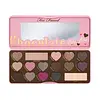What's inside
What's inside
 Key Ingredients
Key Ingredients

 Benefits
Benefits

No benefits
 Concerns
Concerns

 Ingredients Side-by-side
Ingredients Side-by-side

Mica
Cosmetic ColorantTalc
AbrasiveEthylhexyl Palmitate
EmollientBoron Nitride
AbsorbentPolyethylene
AbrasiveSodium Saccharin
MaskingWater
Skin ConditioningEthylene/Acrylic Acid Copolymer
Emulsion StabilisingPhenoxyethanol
PreservativeSodium Dehydroacetate
PreservativeSorbic Acid
PreservativeTheobroma Cacao Fruit Powder
Skin ConditioningVanillin
MaskingZinc Stearate
Cosmetic ColorantCI 75470
Cosmetic ColorantIron Oxides
CI 77891
Cosmetic ColorantMica
Cosmetic ColorantTalc
AbrasiveZinc Stearate
Cosmetic ColorantBoron Nitride
AbsorbentNylon-12
Silica
AbrasiveOctyldodecyl Stearoyl Stearate
EmollientDiisostearyl Malate
EmollientSodium Dehydroacetate
PreservativePhenoxyethanol
PreservativeSorbic Acid
PreservativeTriethoxycaprylylsilane
Cellulose
AbsorbentPolyethylene
AbrasiveTitanium Dioxide
Cosmetic ColorantCI 77742
Cosmetic ColorantIron Oxides
CI 19140
Cosmetic ColorantPCA Dimethicone
Skin ConditioningCalcium Aluminum Borosilicate
Caprylic/Capric Triglyceride
MaskingMagnesium Myristate
Hdi/Trimethylol Hexyllactone Crosspolymer
Caprylyl Glycol
Emollient1,2-Hexanediol
Skin ConditioningTin Oxide
AbrasiveAcrylates Copolymer
Isododecane
EmollientCI 77163
Cosmetic ColorantCI 77891
Cosmetic ColorantCI 75470
Cosmetic ColorantCI 77007
Cosmetic ColorantCalcium Sodium Borosilicate
Dimethicone/Vinyl Dimethicone Crosspolymer
Skin ConditioningEthylhexyl Palmitate
EmollientHexylene Glycol
EmulsifyingMica, Talc, Zinc Stearate, Boron Nitride, Nylon-12, Silica, Octyldodecyl Stearoyl Stearate, Diisostearyl Malate, Sodium Dehydroacetate, Phenoxyethanol, Sorbic Acid, Triethoxycaprylylsilane, Cellulose, Polyethylene, Titanium Dioxide, CI 77742, Iron Oxides, CI 19140, PCA Dimethicone, Calcium Aluminum Borosilicate, Caprylic/Capric Triglyceride, Magnesium Myristate, Hdi/Trimethylol Hexyllactone Crosspolymer, Caprylyl Glycol, 1,2-Hexanediol, Tin Oxide, Acrylates Copolymer, Isododecane, CI 77163, CI 77891, CI 75470, CI 77007, Calcium Sodium Borosilicate, Dimethicone/Vinyl Dimethicone Crosspolymer, Ethylhexyl Palmitate, Hexylene Glycol
Ingredients Explained
These ingredients are found in both products.
Ingredients higher up in an ingredient list are typically present in a larger amount.
Boron Nitride is compound consisting of boron and nitrogen. It is used to absorb oil and modify adherence/ slip in products.
This means it is often used in makeup products to help them last longer.
Ci 75470 is a bright-red pigment. It is AKA carmine.
Carmine is derived from insects such as the cochineal beetle. This ingredient has been used as a natural dye for over 2000 years.
Ci 77891 is a white pigment from Titanium dioxide. It is naturally found in minerals such as rutile and ilmenite.
It's main function is to add a white color to cosmetics. It can also be mixed with other colors to create different shades.
Ci 77891 is commonly found in sunscreens due to its ability to block UV rays.
Learn more about CI 77891Ethylhexyl Palmitate, also known as octyl palmitate, is created from 2-ethylhexyl alcohol and palmitic acid. It is a fatty acid ester.
The fatty acid content of Ethylhexyl Palmitate makes it an emollient. Emollients help soften and hydrate your skin by trapping moisture within.
Ethylhexyl Palmitate is also used to help improve the texture of cosmetics. It helps other ingredient dissolve in products and help disperse ingredients more evenly.
You'll likely find this ingredient in sunscreen, as it is often used to mix UV-blocking ingredients such as avobenzone and ethylhexyl triazone.
It can also help stabilize the fragrances in a product as a fragrance fixative.
Ethylhexyl Palmitate can be used to substitute mineral oil.
Due to its high fatty acid content, it may not be fungal-acne safe.
Learn more about Ethylhexyl PalmitateMica is a naturally occurring mineral used to add shimmer and color in cosmetics. It can also help improve the texture of a product or give it an opaque, white/silver color.
Serecite is the name for very fine but ragged grains of mica.
This ingredient is often coated with metal oxides like titanium dioxide. Trace amounts of heavy metals may be found in mica, but these metals are not harmful in our personal products.
Mica has been used since prehistoric times throughout the world. Ancient Egyptian, Indian, Greek, Roman, Aztec, and Chinese civilizations have used mica.
Learn more about MicaPhenoxyethanol is a preservative that has germicide, antimicrobial, and aromatic properties. Studies show that phenoxyethanol can prevent microbial growth. By itself, it has a scent that is similar to that of a rose.
It's often used in formulations along with Caprylyl Glycol to preserve the shelf life of products.
Polyethylene is a synthetic ingredient that helps the skin retain moisture. It is a polymer.
It is also typically used within product formulations to help bind solid ingredients together and thicken oil-based ingredients. When added to balms and emulsions, it helps increase the melting point temperature.
This ingredient is a preservative with antimicrobial properties. It is the sodium salt of dehydroacetic acid.
It is especially effective at preventing bacterial and fungal growth in low concentrations.
Sorbic Acid is a preservative. It is the most commonly used food preservative in the world.
Sorbic Acid is a natural antibiotic and highly effective at preventing the growth of fungus. It is less effective against bacteria.
Potassium Sorbate, another commonly-used preservative, is the potassium salt of Sorbic Acid.
Sorbic Acid may worsen eczema. We recommend speaking with a professional if you have any concerns.
Potassium sorbate and sorbic acid can be found in baked goods, cheeses, dried meats, dried fruit, ice cream, pickles, wine, yogurt, and more.
Learn more about Sorbic AcidTalc is a clay mineral. It helps absorb moisture and improve the texture of products. Like other types of clay, Talc can have a slight exfoliating effect on skin. Talc can be added to increase the volume of products.
Some Baby powders are made by combining talc with corn starch. The word "talc" comes from Latin and originates from Arabic. Talc is a mineral commonly found throughout the world.
If you have any concerns about using talc, we recommend checking out the FDA's official page.
Learn more about TalcZinc Stearate is the metal salt of stearic acid. It is a white solid used to bind, thicken, and lubricate products.
This ingredient is common in powder makeup, where it helps keep the powder together.
Zinc Stearate is hydrophobic and repels water.
This ingredient can be sourced from non-animal or animal sources. It is best to reach out to the brand to see where they source this ingredient from.
Learn more about Zinc StearateThis ingredient is a combination of red, black, and yellow iron oxide pigments. This combination of colors is usually found in foundation, because it results in a "skin" color.